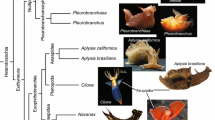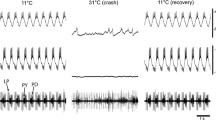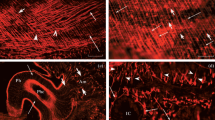Abstract
Crawling gastropods are unique models for studying the functioning of smooth muscles and ciliated epithelia, since they cover the foot sole and are involved in locomotion, allowing for direct investigation. Two types of crawling are known: creeping by muscular waves in terrestrial gastropods such as Helix and сiliary gliding in aquatic gastropods such as Lymnaea. It was found that the smooth muscles that underlie the ciliated epithelium in Lymnaea are involved in gliding and contribute significantly to fast crawling. Thus, the locomotor apparatus is fundamentally the same in both snails and the difference between crawling reflects an adaptation to a habitat. The control of crawling speed is also the same. Tonic contraction, relaxation, and rhythmic contractions are involved in this control. During a locomotor episode, the sole length and crawling speed spontaneously change and directly correlate with each other via the contraction force of the muscle cells in the locomotory waves. Dopamine, unlike ergometrine, decreases the sole length and crawling speed. Serotonin stimulates, increases crawling and determines the number of muscle cells involved in the locomotory waves for each locomotor episode. This control (taking into account heterogeneity) apparently might exist in any other phasic smooth muscle, including vertebrates.








Modified from Pavlova (2001)

(modified from Trueman 1983; Denny 1981). The number of muscle cells involved in the wave is the same in b and c, but their contraction force is greater in b than in c (shown by the thickness and the length of muscle cells) as well as the work performed by the muscle wave (the area of the black rectangles W1 and W2). As a result, the crawling speed (V1 and V2 shown by the length of black arrows) is higher in the relaxed (b) than in the contracted (c) side of the sole (Pavlova 2001)


(modified from Trueman 1983; Denny 1981) before (e) and after (f) 5-HT injection. The contraction force of muscle cells in the wave (line thickness) is the same in e and f. The number of muscle cells in the wave is larger in f than in e and as a result, the work performed by the muscle wave (the area of the black rectangles W1 and W2) and the crawling speed (V1 and V2 shown by the length of the arrows) are greater in f than in e

Similar content being viewed by others
References
Aiello E, Sleigh MA (1972) The metachronal wave of lateral cilia of Mytilus edulis. J Cell Biol 54:493–506
Audesirk G (1978a) Central neuronal control of cilia in Tritonia diomedea. Nature 272:541–543
Audesirk G (1978b) Properties of central motor neurons exciting locomotory cilia in Tritonia diomedea. J comp Physiol 128:259–267
Audesirk G, McCaman RE, Willows AO (1979) The role of serotonin in the control of pedal ciliary activity by identified neurons in Tritonia diomedea. Comp Biochem Physiol C 62(1):87–91
Bakeeva LE, Chentsov YS, Skulachev VP (1981) Ontogenesis of mitochondrial reticulum in rat diaphragm muscle. Eur J Cell Biol 25(1):175–181
Bakeeva LE, Pavlova GA, Rodichev EB (1992) Three-dimensional arrangement of mitochondria in Lymnaea stagnalis smooth muscles. Biokhim 57(8):1155–1164
Brosemer RW, Vogell W, Bücher Th (1963) Morphological and enzymatic patterns in the development of the indirect flight muscle of the locust migratoria. Biochem Z 338:854–910
Buznikov GA, Manukhin BN (1962) The effect of serotonin on motor activity of nudibranch embryos. Zh Obshch Biol 21:347–352
Carew TJ, Pinsker H, Robinson K, Kandel ER (1974) Physiological and biochemical properties of neuromuscular transmission between identified motoneurons and gill muscle in Aplysia. J Neurophysiol 37:1020–1040
Croll RP, Voronezhskaya EE, Hiripi L, Elekes K (1999) Development of catecholaminergic neurons in the pond snail, Lymnaea stagnalis: II. Postembryonic development of central and peripheral cells. J Comp Neurol 404:297–309
Crozier WJ, Pilz GR (1924) The locomotion of Limax. I. Temperature coefficient of pedal activity. J Gen Physiol 6:711–721
Deliagina TG, Orlovsky GN (1990) Control of locomotion in the freshwater snail Planorbis corneus. II. Differential control of various zones of the ciliated epithelium. J exp Biol 152:405–423
Denny MW (1980) The role of gastropod pedal mucus in locomotion. Nat Lond 285:160–161
Denny MW (1981) A quantative model for the adhesive locomotion of the terrestrial slug, Ariolimax columbianus. J Exp Biol 91:195–217
Dyakonova TL (1988) Possible role of neurosecretory cells in regulation of seasonal changes in Helix lucorum. Dokl Akad Nauk 298:242–246
Elekes K, Kemenes G, Hiripi L, Geffard M, Benjamin PR (1991) Dopamine-immunoreactive neurons in the central nervous system of the pond snail Lymnaea stagnalis. J Comp Neurol 307:214–224
Elves MW (1961) The histology of the foot of Discus rotundatus, and the locomotion of gastropod Mollusca. Proc Malac Soc Lond 34:346–355
Goldberg JI, Koehncke NK, Christopher KJ, Neumann C, Diefenbach TJ (1994) Pharmacological characterization of a serotonin receptor involved in an early embryonic behavior of Helisoma trivolvis. J Neurobiol 25:1545–1557
Gray J (1928) Ciliary movement. Cambridge University Press, Cambridge
Hall JD, Lloyd PE (1990) Involvement of pedal peptide in locomotion in Aplysia: modulation of foot muscle contractions. J Neurobiol 21:858–868. https://doi.org/10.1002/neu.480210604
Hanson J, Lowy J (1957) Structure of smooth muscle. Nature 180:906–909
Hemmert HM, Baltzley MJ (2016) Intraspecific scaling relationships between crawling speed and body size in a gastropod. Biol Bull 230(1):78–84
Hernádi L, Hiripi L, Dyakonova V, Győri J. Vehovszky Á (2004) The effect of food intake on the central monoaminergic system in the snail, Lymnaea stagnalis. Acta Biol Hung 55:185–194
Hetherington MS, McKenzie JD, Dean HG, Winlow W (1994) A quantitative analysis of biogenic amines in the central ganglia of the pond snail, Lymnaea stagnalis (L). Comp Biochem Physiol C 107:83–93
Ierusalimsky VN, Zakharov IS, Balaban PM (1997) Comparison of serotonin and dopamine neural systems in adult and juvenile terrestrial snails Helix and Eobania. Zh Vyssh Nerv Deyat 47:563–576
Jerez NC, Calkins CR, Velazco J (2003) Prerigor injection using glycolytic inhibitors in low-quality beef muscles. Anim Sci 81:997–1003
Jones HD (1973) The mechanism of locomotion of Agriolimax reticulatus (Mollusca: Gastropoda). J Zool Lond 171:489–498
Jones HD (1975) Locomotion. In: Fretter V, Peake J (eds) Pulmonates, vol 1. Academic Press, London, pp 1–32
Juel C (1983) Pre- and postsynaptic effects of dopamine antagonists on dopaminergic synaptic transmission in Helix pomatia. Comp Biochem Physiol C 76:203–208
Kado RT (1973) Aplysia giant cell: soma-axon voltage clamp current differences. Science 182(4114):843–845
Kaiser P (1960) Die Leistungen des Flimmerepithels bei der Fortbewegung der Basommatophoren. Z Wiss Zool 162:368–393
Karpovich AL, Smolyaninov VV (1975) On the relationship between the kinematic characteristics of human walking. Hum Physiol 1(1):167–175
Kononenko NL, Zhukov VV (2005) Multiplicity of chemical mechanisms in the regulation of muscle contractions in Lymnaea stagnalis (L). Zh Evol Biokhim Fiziol 41:44–50
Lai JH, del Alamo JC, Rodríguez-Rodríguez J, Lasheras JC (2010) The mechanics of the adhesive locomotion of terrestrial gastropods. J Exp Biol 213:3920–3933. https://doi.org/10.1242/jeb.046706
Li L, Prabhakaran K, Mills EM, Borowitz JL, Isom GE (2005) Enhancement of cyanide-induced mitochondrial dysfunction and cortical cell necrosis by uncoupling protein-2. Toxicol Sci 86:116–124
Lissmann HW (1945a) The mechanism of locomotion in gastropod mollusks. I. Kinematics. J Exp Biol 21:58–69
Lissmann HW (1945b) The mechanism of locomotion in gastropod mollusks. II. Kinetics. J Exp Biol 22:37–50
Lister M (1694) Exercitatio Anatomica in qua de Cochleis maxime terrestribus et Limacibus agitur. London
Lloyd PE, Connolly CE (1989) Sequence of Pedal peptide: a novel neuropeptide from the central nervous system of Aplysia. J Neurosci 9:312–317
Lloyd PE, Phares GA, Phillips NE, Willows AO (1996) Purification and sequencing of neuropeptides from identified neurons in the marine mollusc, Tritonia. Peptides 17(1):17–23
Longley RD (2010) Comparison of control of pedal sole cilia in the snails Lymnaea stagnalis appressa and Helisoma trivolvis. Biol Bull 219(3):283–287
Longley RD, Peterman M (2013) Neuronal control of pedal sole cilia in the pond snail Lymnaea stagnalis appressa. J Comp Physiol A Neuroethol Sens Neural Behav Physiol 199(1):71–86. https://doi.org/10.1007/s00359-012-0770-x. Epub 2012 Nov 3
Mackie GO, Paul DH, Singla CM, Sleigh MA, Williams DE (1974) Branchial innervation and ciliary control in the ascidian Corella. Proc R Soc Lond B Biol Sci 187(1086):1–35
Malyshev AY, Norekian TP, Willows AO (1999) Differential effects of serotonergic and peptidergic cardioexcitatory neurons on the heart activity in the pteropod mollusc, Clione limacina. J Comp Physiol A 185(6):551–560
McCaman MW, Ono JK, McCaman RE (1979) Dopamine measurements in molluscan ganglia and neurones using a new, sensitive technique. J Neurochem 32:1111–1113
McKenzie JD, Syed N, Tripp J, Winlow W (1987) Are the pedal cilia in Lymnaea under neural control? In: Boer HH, Geraerts WPM, Joose J (eds) Neurobiology: molluscan models. Elsevier, Amsterdam, pp 26–30
McKenzie JD, Caunce M, Hetherington MS, Winlow W (1998) Serotonergic innervation of the foot of the pond snail Lymnaea stagnalis (L). J Neurocytol 27:459–470
Mogami Y, Machemer H (1991) A novel type of ciliary activity in Stylonychia mytilus: analysis of potential-coupled motor responses in the transverse cirri. J Exp Biol 161:239–255
Muneoka Y, Twarog BM (1983) Neuromuscular transmission and excitation-contraction coupling in molluscan muscle. In: Saleuddin AS, Wilbur KM (eds) The molluscs, vol 4. Academic Press, New York, pp 35–76
Pavlova GA (1990) Correlation between the sole shape and the gliding locomotor speed in the freshwater snail Lymnaea stagnalis. Zh Evol Biokhim Fiziol 26:702–706
Pavlova GA (1994) Correlation between the sole shape and the locomotor speed in the pulmonate snails Helix lucorum and Helix pomatia. Zh Evol Biokhim Fiziol 26:702–706
Pavlova GA (1996) Serotonin effect on locomotion in the pulmonate mollusc Helix lucorum. Zh Evol Biokhim Fiziol 32:302–307
Pavlova GA (1997) Serotonin effect on locomotion in the freshwater snail Lymnaea stagnalis. Zh Evol Biokhim Fiziol 33:599–606
Pavlova GA (2001) Effects of serotonin, dopamine and ergometrine on locomotion in the pulmonate mollusc Helix lucorum. J Exp Biol 204:1625–1633
Pavlova GA (2006) The velocity of gliding of a freshwater gastropod depends on its muscular activity. Dokl Biol Sci 410:358–360
Pavlova GA (2010) Muscular waves contribute to gliding rate in the freshwater gastropod Lymnaea stagnalis. J Comp Physiol A 196:241–248
Pavlova GA (2013) Sole smooth muscle states determine gliding rate in the freshwater snail Lymnaea stagnalis. Biol Bull 225:184–193
Pavlova GA (2014) Serotonin does not enhance locomotor activity in the pond snail Lymnaea stagnalis in winter. Zh Evol Biokhim Fiziol 50(1):78–79
Pavlova GA (2015) Determination of cilium power on the foot sole of the freshwater snail, Lymnaea stagnalis. Biophysics 60(1):131–134. https://doi.org/10.1134/S0006350915010200
Pavlova GA, Bakeeva LE (1993) Locomotor activity of denervated sole in the freshwater snail Lymnaea stagnalis. Zh Evol Biokhim Fiziol 29:495–501
Pavlova GA, Willows AOD (2005) Immunological localization of Tritonia peptide in the central and peripheral nervous system of the terrestrial snail Helix aspersa. J Comp Neurol 491:15–26
Plesch B, Janse C, Boer HH (1975) Gross morphology and histology of the musculature of the freshwater pulmonate Lymnaea stagnalis (L.). Neth J Zool 25:332–352
Poteryaev DA, Zakharov IS, Balaban PM, Uvarov PN, Belyavsky AV (1997) Characterization of a cDNA clone encoding pedal peptide in the terrestrial snail. NeuroReport 8:3631–3635
Prosser CL (1962) Conduction in nonstriated muscles. Physiol Rev Supplement 5:193–212
Prosser CL, Sperelakis N (1956) Transmission in ganglion-free circular muscle from cat intestine. Am J Physiol 187:536–545
Rogers DC (1969) Fine structure of smooth muscle and neuromuscular junctions in the foot of Helix aspersa. Z Zellforsch 99:315–335
Sakharov DA, Kabotyansky EA (1986) Integration of behaviour of a pteropod mollusk by dopamine and serotonin. Zh Obshch Biol 47:234–245 (in Russian)
Sawada M, Maeno T (1987) Forskolin mimics the dopamine-induced K+ conductance increase in identified neurons of Aplysia kurodai. Jap J Physiol 37:459–478
Seidman L, Entner N (1961) Oxidative enzymes and their role in phosphorylation in sarcosomes of adult Ascaris lumbricoides. J Biol Chem 236:915–919
Shozushima M (1984) Blocking effects of serotonin on inhibitory dopamine receptor activity of Aplysia ganglion cells. Jap J Physiol 34:225–243
Skulachev VP (1969) Energy accumulation in the cell. Nauka, Moscow
Suarez RK, Lighton JR, Brown GS, Mathieu-Costello O (1991) Mitochondrial respiration in hummingbird flight muscles. Proc Natl Acad Sci 88:4870–4873
Syed N, Winlow W (1989) Morphology and electrophysiology of neurons innervating the ciliated locomotor epithelium in Lymnaea stagnalis (L.). Comp Biochem Physiol A 93(3):633–644
Syed N, Harrison D, Winlow W (1988) Locomotion in Lymnaea: role of serotonergic motoneurons controlling the pedal cilia. A-cluster neurones. In: Salanki J, Roza KS (eds) Neurobiology of invertebrates. Symp Biol Hung 36:387–402
Tielens AG, Rotte C, van Hellemond JJ, Martin W (2002) Mitochondria as we don’t know them. Trends Biochem Sci 27(11):564–572
Trueman ER (1983) Locomotion in mollusks. In: Saleuddin AS, Wilbur KM (eds) The mollusks, vol 4. Academic Press, New York, pp 155–197
Williams AC, Ford WC (2001) The role of glucose in supporting motility and capacitation in human spermatozoa. J Androl 22:680–695
Willows AOD, Pavlova GA, Phillips NE (1997) Modulation of ciliary beat frequency by neuropeptides from identified molluscan neurons. J Exp Biol 200:1433–1439
Willows AOD, Pavlova GA, Phillips NE (1998) Effects of Tritonia neuropeptides and serotonin on ciliary activity. Dokl Acad Nauk 358:839–841
Winkler BS, Sauer MW, Starnes CA (2003) Modulation of the Pasteur effect in retinal cells: implications for understanding compensatory metabolic mechanisms. Exp Eye Res 76:715–772
Zylstra U (1972) Histochemistry and ultrastructure of the epidermis and the subepidermal gland cells of the freshwater snails Lymnaea stagnalis and Biomphalaria pfeifferi. Z Zellforsch 130:93–134
Acknowledgements
I am grateful to the Russian Foundation for Basic Research, which supported my study for years, including grant #13-04-01052. I thank all my colleagues who participated in this research and two anonymous reviewers who gave me useful recommendations and helped to improve the manuscript. The experiments complied with the ‘Rules of laboratory practice’ (RLP) in the Russian Federation no. 267 revised in 2003 from the Ministry of Health, with the current laws in Moscow State University, and they were also approved by the Ethics Committee of the A. N. Belozersky Institute.
Author information
Authors and Affiliations
Corresponding author
Rights and permissions
About this article
Cite this article
Pavlova, G.A. The similarity of crawling mechanisms in aquatic and terrestrial gastropods. J Comp Physiol A 205, 1–11 (2019). https://doi.org/10.1007/s00359-018-1294-9
Received:
Revised:
Accepted:
Published:
Issue Date:
DOI: https://doi.org/10.1007/s00359-018-1294-9




